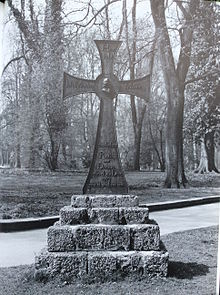Johann Martin Miller

Johann Martin Miller (3 December 1750 in
Life
Miller, the son of the Evangelical pastor Johann Michael Miller (1722–1774), was born in Jungingen, nowadays part of the city of Ulm. From 15 October 1770,[1] he studied theology at the University of Göttingen, where he helped to establish the Göttinger Hainbund. Through this literary group, founded in 1772, Miller became acquainted with Matthias Claudius, Gottfried August Bürger, Ludwig Christoph Heinrich Hölty, Johann Heinrich Voss, and Friedrich Gottlieb Klopstock. In 1774 he accompanied Klopstock from Göttingen to Hamburg. In 1774 and 1775 he studied in Leipzig.

After his student years in Göttingen, Miller was active in Ulm and its surroundings: from 1780 onwards as a pastor, from 1781 as a teacher in the local high school, and from 1783 as a cathedral preacher in the
Miller joined Freemasonry on 13 October 1774 at the Zum goldenen Zirkel lodge in Göttingen. On 11 December 1776 he was elected a fellow-craft. In 1775 he helped found the Zur goldenen Kugel lodge in Hamburg. For a long time he was speaker at the Asträa zu den 3 Ulmen lodge in Ulm (which was shut during the period 1795-1807).[9]
On 21 June 1814, Johann Martin Miller died at the age of sixty-four in Ulm. A short autobiographical essay, written by Miller in 1793 and published in a widely read periodical, is one of the main sources of his life.
His collected poems appeared in 2016 (the 200th anniversary of his death) with Elfenbein Verlag in Berlin - for the first time in 1783.
Works
- Beytrag zur Geschichte der Zärtlichkeit. Aus den Briefen zweier Liebenden ("Towards a History of Tenderness. From the Letters of Two Lovers," 1776, reprinted with appendix in 1780)
- Siegwart. Eine Klostergeschichte ("Siegwart, a Monastic Tale", 1776) (facsimile scan at Deutsches Textarchiv)
- Briefwechsel dreyer akademischer Freunde ("Correspondence of Three friends at the Academy", 1776)
- Geschichte Karls von Burgheim und Emiliens von Rosenau ("Tale of Karl von Burgheim and Emilie von Rosenau", 1778)
- Johann Martin Millers Gedichte ("Johann Martin Miller's Poems", 1783)
- Karl und Karoline ("Carl and Caroline") (1783)
- Briefwechsel zwischen einem Vater und seinem Sohn auf der Akademie ("Correspondence of a Father and a Son on the Academy", 1785)
- Die Geschichte Gottfried Walthers, eines Tischlers, und des Städtleins Erlenburg ("The Story of Gottfried Walther, a Joiner, and the Little Town of Erlenburg", 1786)
Available Editions
- Liederton und Triller. Sämtliche Gedichte, ed., commentary and postface by Michael Watzka. Berlin: ISBN 978-3-941184-30-5.
Sources
- Bernd Breitenbuch: Johann Martin Miller 1750-1814. Liederdichter des Göttinger Hain, Romancier, Prediger am Ulmer Münster. Ausstellung zum 250. Geburtstag. Stadtbibliothek Ulm, Schwörhaus, 3. Dezember 2000 bis 27. Januar 2001. Weißenhorn: Konrad 2000. (= Veröffentlichungen der Stadtbibliothek Ulm; 20) ISBN 3-87437-448-3
- Bernd Breitenbruch: "Johann Martin Millers Romane und ihre Nachdrucke. Mit Beiträgen zu den Reutlinger und Tübinger Nachdrucken", in: Jahrbuch des Freien Deutschen Hochstifts 2013. Göttingen/Tübingen, 2014, pp. 83–145.
- Adalbert Elschenbroich (1994), "Miller, Johann Martin", Neue Deutsche Biographie (in German), vol. 17, Berlin: Duncker & Humblot, pp. 514–516; (full text online)
- Alain Faure: Johann Martin Miller, romancier sentimental. Paris: Champion 1977.
- Hans-Edwin Friedrich: "Autonomie der Liebe - Autonomie des Romans. Zur Funktion von Liebe im Roman der 1770er Jahre: Goethes Werther und Millers Siegwart" (30. Juli 2004), in: [Goethezeitportal.http://www.goethezeitportal.de/db/wiss/epoche/friedrich_liebe.pdf]
- Heinrich Kraeger: Johann Martin Miller. Ein Beitrag zur Geschichte der Empfindsamkeit. Bremen: Heinsius 1893.
- Erich Schmidt: Miller, Johann Martin, in: Allgemeine Deutsche Biographie (ADB). Band 21, Duncker & Humblot, Leipzig 1885, pp. 750–755.
- Frank Raberg: Biografisches Lexikon für Ulm und Neu-Ulm 1802–2009. Süddeutsche Verlagsgesellschaft Ulm im Jan Thorbecke Verlag, Ostfildern 2010, ISBN 978-3-7995-8040-3, pp. 275 f.
- Reinhart Schönsee: J. M. Millers Prosaschriften als Krisenphänomen ihrer Epoche. Hamburg: Univ. Diss. 1972.
- Manfred von Stosch (Hg.): Der Briefwechsel zwischen Johann Martin Miller und Johann Heinrich Voss. Berlin: De Gruyter 2012. ISBN 3-11-023417-3(correspondence with J. H. Voss)
- Heinz Strauss: Der Klosterroman von Millers 'Siegwart' bis zu seiner künstlerischen Höhe bei E. T. A. Hoffmann. Ein Beitrag zur Literaturgeschichte des 12. Jahrhunderts. München: Univ. Diss. 1922.
- Michael Watzka: "Ein One-Hit-Wonder? Die Lyrik Johann Martin Millers in den Kompositionen seiner Zeitgenossen", in: Lenz-Jahrbuch 21, 2014, S. 111–146. ISSN 0940-7499.
External links
- Works by or about Johann Martin Miller at Internet Archive
- Works by Johann Martin Miller at LibriVox (public domain audiobooks)

- Literature by and about Johann Martin Miller in the German National Library catalogue
- Works by and about Johann Martin Miller in the Deutsche Digitale Bibliothek (German Digital Library)
- "Works by Johann Martin Miller". Zeno.org (in German).
- Porträt in der Südwet Presse Ulm
References
- ^ Götz von Selle. Die Matrikel der... Universität zu Göttingen 1734-1837. Hildesheim, Leipzig 1937, Nr. 8619
- ^ Michael Watzka: Ein One-Hit-Wonder? Die Lyrik Johann Martin Millers in den Kompositionen seiner Zeitgenossen, in: Lenz-Jahrbuch 21 (2014). St. Ingbert 2015.
- ^ Liederton und Triller. Sämtliche Gedichte, ed. by Michael Watzka. Berlin 2014, p. 245.
- ^ Bernd Breitenbruch: Johann Martin Millers Romane und ihre Nachdrucke, in: Jahrbuch des Freien Deutschen Hochstifts 2013, p. 90.
- ^ E. Schmitt. Die Wohlersche Buchhandlung in Ulm. S. 64
- ^ Erich Schmidt in Allgemeine Deutsche Biographie. Bd. 21, 1885, S. 750-755
- ^ Bernd Breitenbruch: "Johann Martin Millers Romane und ihre Nachdrucke. Mit Beiträgen zu den Reutlinger und Tübinger Nachdrucken", in: Jahrbuch des Freien Deutschen Hochstifts 2013. Göttingen/Tübingen, 2014, pp. 83.
- ^ Bernhard Appenzeller. Die Münsterprediger bis zum Übergang Ulms an Württemberg 1810. Weißenhorn 1990, S. 404-412
- ^ Matrikel der Loge Zum goldenen Zirkel im Geh. Staatsarchiv Berlin-Dahlem, Sign. 5.2 G 31 Nr. 19
